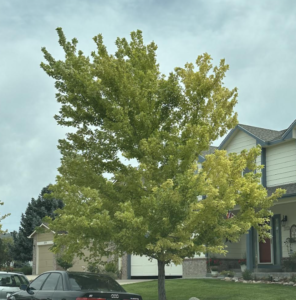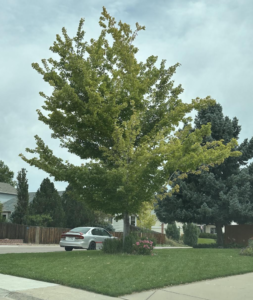Iron Chlorosis Treatment in Denver
If you’ve discovered a yellowing of your tree’s leaves during the summer months, your tree most likely is suffering from Iron Chlorosis. Luckily, this issue is rectifiable with proper treatment. Contact us today for a fast and free estimate, and we’ll walk you through your best options. We have multiple college degrees and multiple ISA-certified arborists on staff, a rarity in the industry, making us the most educated and experienced experts for treating this issue in Denver.
Why Am I So Yellow?
Does your Red Oak or Maple (species) have yellowing leaves in July? Does it have some burning leaves in July?
These could be symptoms of a nutrient deficiency called Iron Chlorosis. The symptoms manifest the same between Red Oaks and Maple species. Leaf tissue sampling is the only way to determine if the chlorosis is due to an iron deficiency or a manganese deficiency. Root causes of Iron Chlorosis can vary vastly. Additionally, there are other Plant Health Care issues that may be the cause of Iron Chlorosis that may not be related to Iron Chlorosis. This is why it is important to have a Bailey Tree Arborist assess your tree and provide the correct diagnosis and recommendations for your tree.
Call Bailey Tree Today for Your Free Iron Chlorosis Estimate!
The most visible initial symptoms occur, most of the time, around the middle of July when the leaf starts to fade to yellow, but the area near the leaf veins maintain their green appearance. If left untreated for a period of time the deficiency will lead to “chlorotic burn;” leaf tips that lack chlorophyll protecting them from the sun will brown and burn. Prior to the chlorotic burn brownish to black spots may even appear. Over time, these small twigs will die back leading to larger branch death.
The soils along the Front Range have an abundance of Iron. It is important to note that Iron Chlorosis is still not fully understood and still being researched. There are several factors that can lead to a tree developing the deficiency:
- Over-watering/extreme drought-can predispose plants
- High pH soils-a chemical reaction that binds iron to clay soil particles resulting in form that is insoluble for uptake by the plant. Soil applications of chelated iron are only a temporary relief and require multiple annual treatments. Iron does not readily absorb into older tissue. Best Management Practices recommend spring applications only.
- Soil compaction-reduction of Oxygen pore space
- Trunk or Stem Girdling Roots-these restrict the uptake and/or movement of water and nutrients up into the tree
- Plant competition
- Winter injury (freeze damage)
- Soil Organic Matter Availability
- Excessive Salt Levels
- Soil Temperature and Light Intensity
- Acid-Loving Plants
- Nutrient Levels
- Plant Selection-Right Plant, Right Place
 There are areas throughout town where the soil conditions are perfect for these species of trees. And a great Arborist will know these areas of town.
There are areas throughout town where the soil conditions are perfect for these species of trees. And a great Arborist will know these areas of town.
At Bailey Tree, our “Toolbox,” if your tree is diagnosed with Iron Chlorosis, we have the perfect program to manage an Iron and/or Manganese Deficiency to preserve the overall health. While we are not able to change the soil the tree is living in, we can make strides to feed the soil which will in turn benefit soil microbes that benefit the tree. We also have systemic soil and trunk treatment methods to make dramatic strides to reduce the impact of the deficiency having on your tree!
Start a Free Estimate!

